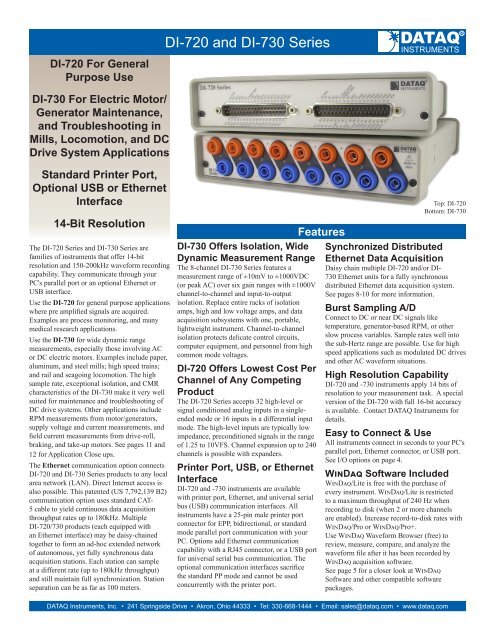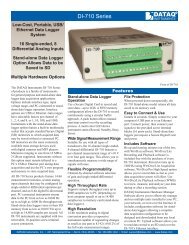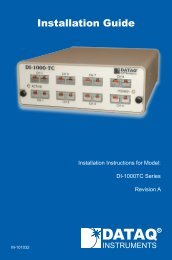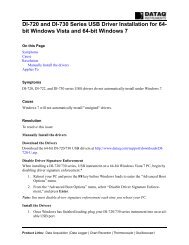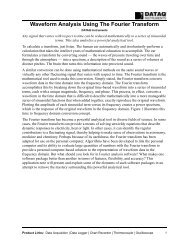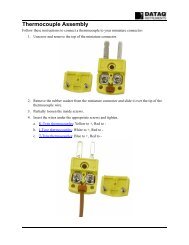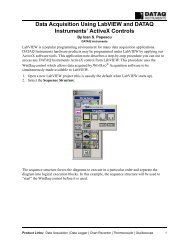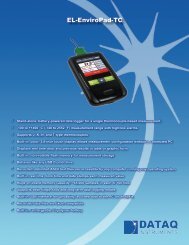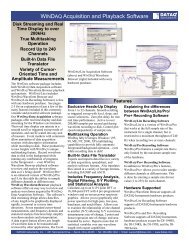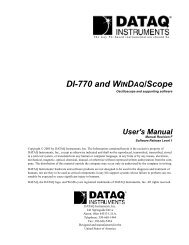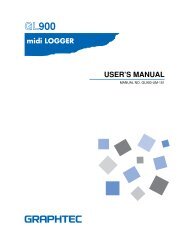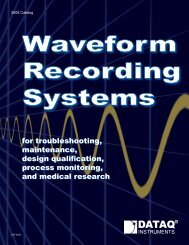DI-720 datasheet - DATAQ Instruments
DI-720 datasheet - DATAQ Instruments
DI-720 datasheet - DATAQ Instruments
Create successful ePaper yourself
Turn your PDF publications into a flip-book with our unique Google optimized e-Paper software.
<strong>DI</strong>-<strong>720</strong> For General<br />
Purpose Use<br />
<strong>DI</strong>-<strong>720</strong> and <strong>DI</strong>-730 Series<br />
<strong>DI</strong>-730 For Electric Motor/<br />
Generator Maintenance,<br />
and Troubleshooting in<br />
Mills, Locomotion, and DC<br />
Drive System Applications<br />
Standard Printer Port,<br />
Optional USB or Ethernet<br />
Interface<br />
14-Bit Resolution<br />
The <strong>DI</strong>-<strong>720</strong> Series and <strong>DI</strong>-730 Series are<br />
families of instruments that offer 14-bit<br />
resolution and 150-200kHz waveform recording<br />
capability. They communicate through your<br />
PC's parallel port or an optional Ethernet or<br />
USB interface.<br />
Use the <strong>DI</strong>-<strong>720</strong> for general purpose applications<br />
where pre amplified signals are acquired.<br />
Examples are process monitoring, and many<br />
medical research applications.<br />
Use the <strong>DI</strong>-730 for wide dynamic range<br />
measurements, especially those involving AC<br />
or DC electric motors. Examples include paper,<br />
aluminum, and steel mills; high speed trains;<br />
and rail and seagoing locomotion. The high<br />
sample rate, exceptional isolation, and CMR<br />
characteristics of the <strong>DI</strong>-730 make it very well<br />
suited for maintenance and troubleshooting of<br />
DC drive systems. Other applications include<br />
RPM measurements from motor/generators,<br />
supply voltage and current measurements, and<br />
field current measurements from drive-roll,<br />
braking, and take-up motors. See pages 11 and<br />
12 for Application Close ups.<br />
The Ethernet communication option connects<br />
<strong>DI</strong>-<strong>720</strong> and <strong>DI</strong>-730 Series products to any local<br />
area network (LAN). Direct Internet access is<br />
also possible. This patented (US 7,792,139 B2)<br />
communication option uses standard CAT-<br />
5 cable to yield continuous data acquisition<br />
throughput rates up to 180kHz. Multiple<br />
<strong>DI</strong>-<strong>720</strong>/730 products (each equipped with<br />
an Ethernet interface) may be daisy-chained<br />
together to form an ad-hoc extended network<br />
of autonomous, yet fully synchronous data<br />
acquisition stations. Each station can sample<br />
at a different rate (up to 180kHz throughput)<br />
and still maintain full synchronization. Station<br />
separation can be as far as 100 meters.<br />
<strong>DI</strong>-730 Offers Isolation, Wide<br />
Dynamic Measurement Range<br />
The 8-channel <strong>DI</strong>-730 Series features a<br />
measurement range of ±10mV to ±1000VDC<br />
(or peak AC) over six gain ranges with ±1000V<br />
channel-to-channel and input-to-output<br />
isolation. Replace entire racks of isolation<br />
amps, high and low voltage amps, and data<br />
acquisition subsystems with one, portable,<br />
lightweight instrument. Channel-to-channel<br />
isolation protects delicate control circuits,<br />
computer equipment, and personnel from high<br />
common mode voltages.<br />
<strong>DI</strong>-<strong>720</strong> Offers Lowest Cost Per<br />
Channel of Any Competing<br />
Product<br />
The <strong>DI</strong>-<strong>720</strong> Series accepts 32 high-level or<br />
signal conditioned analog inputs in a singleended<br />
mode or 16 inputs in a differential input<br />
mode. The high-level inputs are typically low<br />
impedance, preconditioned signals in the range<br />
of 1.25 to 10VFS. Channel expansion up to 240<br />
channels is possible with expanders.<br />
Printer Port, USB, or Ethernet<br />
Interface<br />
<strong>DI</strong>-<strong>720</strong> and -730 instruments are available<br />
with printer port, Ethernet, and universal serial<br />
bus (USB) communication interfaces. All<br />
instruments have a 25-pin male printer port<br />
connector for EPP, bidirectional, or standard<br />
mode parallel port communication with your<br />
PC. Options add Ethernet communication<br />
capability with a RJ45 connector, or a USB port<br />
for universal serial bus communication. The<br />
optional communication interfaces sacrifice<br />
the standard PP mode and cannot be used<br />
concurrently with the printer port.<br />
Features<br />
Top: <strong>DI</strong>-<strong>720</strong><br />
Bottom: <strong>DI</strong>-730<br />
Synchronized Distributed<br />
Ethernet Data Acquisition<br />
Daisy chain multiple <strong>DI</strong>-<strong>720</strong> and/or <strong>DI</strong>-<br />
730 Ethernet units for a fully synchronous<br />
distributed Ethernet data acquisition system.<br />
See pages 8-10 for more information.<br />
Burst Sampling A/D<br />
Connect to DC or near DC signals like<br />
temperature, generator-based RPM, or other<br />
slow process variables. Sample rates well into<br />
the sub-Hertz range are possible. Use for high<br />
speed applications such as modulated DC drives<br />
and other AC waveform situations.<br />
High Resolution Capability<br />
<strong>DI</strong>-<strong>720</strong> and -730 instruments apply 14 bits of<br />
resolution to your measurement task. A special<br />
version of the <strong>DI</strong>-<strong>720</strong> with full 16-bit accuracy<br />
is available. Contact <strong>DATAQ</strong> <strong>Instruments</strong> for<br />
details.<br />
Easy to Connect & Use<br />
All instruments connect in seconds to your PC's<br />
parallel port, Ethernet connector, or USB port.<br />
See I/O options on page 4.<br />
WinDaq Software Included<br />
WinDaq/Lite is free with the purchase of<br />
every instrument. WinDaq/Lite is restricted<br />
to a maximum throughput of 240 Hz when<br />
recording to disk (when 2 or more channels<br />
are enabled). Increase record-to-disk rates with<br />
WinDaq/Pro or WinDaq/Pro+.<br />
Use WinDaq Waveform Browser (free) to<br />
review, measure, compare, and analyze the<br />
waveform file after it has been recorded by<br />
WinDaq acquisition software.<br />
See page 5 for a closer look at WinDaq<br />
Software and other compatible software<br />
packages.<br />
<strong>DATAQ</strong> <strong>Instruments</strong>, Inc. • 241 Springside Drive • Akron, Ohio 44333 • Tel: 330-668-1444 • Email: sales@dataq.com • www.dataq.com
<strong>DI</strong>-<strong>720</strong> Input Configuration<br />
<strong>DI</strong>-<strong>720</strong> Front Panel<br />
Access to channels 1 through 16 and I/O accessories<br />
via 37-pin D type, male connector.<br />
Access to channels 17 through 32 and expansion accessories<br />
via 37-pin D type, male connector.<br />
All channels support a measurement range of ±10VFS. Single-ended, differential, and gain factors of 1, 2, 4, and 8 are programmable per channel.<br />
<strong>DI</strong>-<strong>720</strong> Analog Input Block Diagram<br />
330-668-1444 2 www.dataq.com
<strong>DI</strong>-730 Input Configuration<br />
<strong>DI</strong>-730 Front Panel<br />
Each of eight fully differential and isolated channels support ±10mV to ±1000V measurements across six programmable ranges. Access is via recessed<br />
banana sockets.<br />
<strong>DI</strong>-730 Analog Input Block Diagram<br />
<strong>DI</strong>-<strong>720</strong> and <strong>DI</strong>-730 Rear Panel I/O (USB and PP)<br />
Analog expansion port* Optional USB port 5-pin <strong>DI</strong>N power connector (9-36 VDC) Power switch<br />
Parallel port (standard on all models)<br />
*16SE/8<strong>DI</strong> Inputs. Programmable ±1.25 to 10 VFS.<br />
ACTIVE LED indicates<br />
data acquisition activity<br />
POWER LED indicates<br />
power is applied<br />
www.dataq.com 3 330-668-1444
<strong>DI</strong>-<strong>720</strong> and <strong>DI</strong>-730 Interface Options<br />
Parallel Port<br />
Models <strong>DI</strong>-<strong>720</strong>-P or <strong>DI</strong>-730-P<br />
Ethernet<br />
Models <strong>DI</strong>-<strong>720</strong>-EN or <strong>DI</strong>-730-EN<br />
USB<br />
Models <strong>DI</strong>-<strong>720</strong>-USB or <strong>DI</strong>-730-USB<br />
Maximum Distance<br />
6 feet (2 meters)<br />
10/100base-T<br />
Maximum Distance*<br />
328 feet/segment (100 meters/segment)<br />
Maximum Distance<br />
16 feet (5 meters)<br />
Maximum Sample Speed**<br />
EPP/<strong>720</strong>: 200 kHz<br />
EPP/730: 150 kHz<br />
Bidirectional: 80 kHz<br />
Standard: 40 kHz<br />
Benefits<br />
• Connects to PCs with no Ethernet or USB<br />
interface.<br />
Maximum Sample Speed**<br />
<strong>DI</strong>-<strong>720</strong>: 180 kHz<br />
<strong>DI</strong>-730: 150 kHz<br />
Benefits<br />
• Connects to any established Ethernet<br />
network.<br />
• Inexpensive cabling<br />
• TCP/IP internet accessible<br />
• Daisy-chain multiple units for a fully<br />
synchronous distributed data acquisition<br />
system<br />
Maximum Sample Speed**<br />
<strong>DI</strong>-<strong>720</strong>: 200 kHz***<br />
<strong>DI</strong>-730: 150 kHz<br />
Benefits<br />
• Plug and play configuration<br />
• "Hot swap" capability<br />
*Expandable to over 1 mile (2 kilometers) with commonly available repeaters.<br />
**Maximum stream-to-disc rate using WINDAQ software on a 350 MHz Pentium II machine running Windows 98. Triggered storage rates will be faster. Contact<br />
<strong>DATAQ</strong> <strong>Instruments</strong> to determine expected maximum sample rates for other machine speeds and operating systems.<br />
***Using Last Point Acquisition Mode. Other modes are limited to 150 kHz.<br />
330-668-1444 4 www.dataq.com
WinDaq…The Most Widely Used Turnkey Test Instrumentation Software *<br />
Record…<br />
Record analog channel data using WinDaq’s continuous recording<br />
mode, or its triggered mode with selectable trigger level, slope,<br />
and pre- and post-trigger times. WinDaq automatically time- and<br />
date-stamps, then streams acquired data and your commented event<br />
markers to disk—acquire as much data as you need. At the same<br />
time, WinDaq reveals on your monitor a real time graphical display<br />
of any or all channels, so you can easily chart your progress,<br />
identify critical events, and plan your next action. No other product<br />
gives you WinDaq’s power, speed, and flexibility. That’s why it’s<br />
the most widely used turnkey software package for PC-based test<br />
instrumentation.<br />
Review…<br />
Use the WinDaq Waveform Browser to review, compare,<br />
qualify, and export recorded waveform data in<br />
ways you've never seen on a PC. Compress an entire<br />
session's recording to one screen width for a bird's eye<br />
view, then expand around an area of interest for a closer<br />
look. Use cursors to precisely measure amplitudes<br />
and timing. Move to any event marker in the file with<br />
the click of a mouse button. Then access WinDaq’s<br />
wealth of analysis tools to gain further insight. And<br />
you can do it all immediately, without the burden of<br />
programming.<br />
and Analyze the Results.<br />
Waveform interpretation is easy with our built-in<br />
analysis functions. Apply frequency and filtering<br />
analysis with the WinDaq Waveform Browser's<br />
FFT and DFT functions. Or analyze any range of<br />
waveform data with its statistics function. Use X-Y<br />
plotting to examine the relationships of one channel<br />
to another. You'll gain insights you never thought<br />
possible. Advanced CODAS allows additional<br />
software analysis functions such as waveform<br />
integration, differentiation, arithmetic operations,<br />
peak detection, and more. Then export waveform<br />
graphics or data to any other application.<br />
*<br />
Source: Test & Measurement World Market Insight Study, PC-based Test Instrumentation, May 1998<br />
www.dataq.com 5 330-668-1444
Ethernet Interface* Close-up<br />
Our third generation Ethernet interface offers a number of advantages over USB and printer port alternatives. Of course, the Ethernet<br />
option allows CAT-5 cable lengths up to 100 meters without hubs over a local area network (LAN), as well as access from any location<br />
using the Internet with a properly configured network. But Ethernet interfaces also allow multiple <strong>DI</strong>-<strong>720</strong>/-730 products to be<br />
connected together for channel expansion. Data acquired across multiple units are acquired synchronously, meaning that samples fall<br />
within a definable time window with constant latency. For example, the torque, load and rpm of multiple rolling stations in a rolling<br />
mill, each instrumented with a <strong>DI</strong>-730 product, may be precisely correlated as an aid to maintenance and troubleshooting, and the<br />
distance between each station can be as great as 100 meters. Finally, the synchronized and distributed nature of these products with an<br />
Ethernet interface is simplified by allowing common CAT-5 cable to be strung between units in a daisy-chain fashion without the need<br />
for external hubs or switches or costly custom cables.<br />
Ethernet Rear Panel<br />
Optional Ethernet interface allows<br />
Analog expansion port* 5-pin <strong>DI</strong>N power connector (9-36 VDC) Power switch<br />
multiple units to be daisy-chained<br />
Parallel port (standard on all models)<br />
*16SE/8<strong>DI</strong> Inputs. Programmable ±1.25 to 10 VFS.<br />
ACTIVE LED indicates<br />
data acquisition activity<br />
POWER LED indicates<br />
power is applied<br />
Ethernet Block Diagram<br />
*Patented (US 7,792,139 B2)<br />
330-668-1444 6 www.dataq.com
Ethernet Expansion Examples<br />
1. Local, Synchronous Expansion<br />
Connect and stack multiple Ethernet versions of <strong>DI</strong>-<strong>720</strong><br />
Series instruments (<strong>DI</strong>-<strong>720</strong> or <strong>DI</strong>-722) or the <strong>DI</strong>-730<br />
together in any combination. Synchronization between<br />
units is guaranteed, and the PC may be local to 100<br />
meters distant from the data acquisition hardware.<br />
1<br />
2. Add Isolated Amplifier Backpacks<br />
Add expansion backpacks like the <strong>DI</strong>-75B and <strong>DI</strong>-78B to<br />
the mix. Doing so preserves synchronization, increases<br />
channel count, and brings the full spectrum of 5B and 8B<br />
isolation amplifiers to bear on your measurement tasks.<br />
2<br />
3. Distributed, Synchronous Expansion<br />
Create multiple measurement stations of any combination<br />
of <strong>DI</strong>-<strong>720</strong>, -722, or -730 instruments, with or without<br />
amplifier backpacks. Individual stations may be separated<br />
from adjacent stations by up to 100 meters to yield<br />
virtually unlimited overall lengths, with synchronization<br />
guaranteed across the entire span.<br />
Key<br />
A = <strong>DI</strong>-<strong>720</strong>, -722, or -730 Unit<br />
B = Isolated Expansion Backpack (<strong>DI</strong>-78B or <strong>DI</strong>-75B)<br />
Connects to Ethernet Port on PC or LAN<br />
Daisy-chain Cables<br />
Connects to next Unit in the Chain<br />
(All cables can be up to 100 meters)<br />
3<br />
www.dataq.com 7 330-668-1444
Primary Synchronous Data Acquisition Customers<br />
Primary Customers<br />
Primary customers include:<br />
• Those who need to acquire data from a remote location where it is not practical or<br />
economical to leave a computer.<br />
• Users who want a path to easily expand their measurement channels at some future<br />
point.<br />
• Customers who need synchronized data acquisition measurements across data<br />
acquisition units.<br />
• Troubleshooters/designers who need fine, synchronous measurements to well within<br />
millisecond resolution.<br />
• Customers who need fast, synchronized measurements across multiple, distributed<br />
data acquisition stations spaced as far as 100 meters between stations.<br />
Typical Applications<br />
Typical application examples include maintenance and troubleshooting applications in:<br />
Large web offset and printing press machinery<br />
Hydraulic metalworking presses<br />
Injection moulding machines<br />
Reversing mills<br />
Steel and aluminum rolling mills<br />
including:<br />
• Roughing mills<br />
• Intermediate mills<br />
• Finishing mills<br />
• Cold rolling tandem mills<br />
• Cluster mills<br />
• Temper rolling mills<br />
• Coilers<br />
Paper mills, including:<br />
• Wire processes<br />
• Presses<br />
• Dryers<br />
• Size presses<br />
• Calendars<br />
• Reelers<br />
• Unwinders and slitters<br />
Structural wind/weather audits on large<br />
structures:<br />
• Tall buildings<br />
• Long bridge spans<br />
• Floating platforms like oil rigs<br />
• Extended length vessels like super<br />
tankers<br />
• Any size structure that requires a<br />
distributed, yet synchronized approach<br />
to data acquisition<br />
PLC fine tuning and troubleshooting to<br />
detect:<br />
• Electrical sequencing variations and<br />
flaws<br />
• Mechanical valve actuation latencies<br />
• Motor timing conflicts<br />
• Hydraulic spikes or drop outs<br />
Typical Measurements<br />
Typical measurements include:<br />
AC/DC drive/motor measurements,<br />
including:<br />
• Speed (armature voltage)<br />
• Speed regulation (tach vs. set point)<br />
• Torque (armature current)<br />
• Acceleration/deceleration times<br />
• IR compensation<br />
• Load balancing<br />
Mechanical properties measurements,<br />
including:<br />
• Load/pressure/stress<br />
• Vibration<br />
• Temperature<br />
• Flow<br />
• Distance/movement<br />
• Tension/compression<br />
330-668-1444 8 www.dataq.com
Typical Application<br />
www.dataq.com 9 330-668-1444
Software for Synchronous Data Acquisition<br />
To next <strong>DI</strong>-<strong>720</strong> or <strong>DI</strong>-730<br />
Series Instrument<br />
Record and Playback all data synchronously. The TCP/IP Manager (above) allows you to<br />
record from all daisy-chained instruments at the click of a button. The WinDaq Waveform<br />
Navigator (below) allows you to view all your data perfectly aligned in time.<br />
CAT-5 Ethernet Cable*<br />
*Up to 100 meters.<br />
330-668-1444 10 www.dataq.com
<strong>DI</strong>-730 Series Data Acquisition Hardware<br />
Application Close up: Steel rolling mill<br />
In the United States, more electric motors are in use than<br />
there are people. Motors can be found at virtually all levels of<br />
production, from mining raw materials and processing them into<br />
finished goods, to transporting these to market. Examples include<br />
open pit mining machines, steel and steel rolling mills, aluminum<br />
rolling mills, paper mills, heavy duty cranes, heavy duty<br />
construction equipment, electric locomotion by rail and sea, and<br />
high speed transit cars. In these applications, the costs associated<br />
with system down time caused by a motor failure can be severe.<br />
Therefore, motor maintenance and troubleshooting is a major<br />
activity in many industries across the country, and the <strong>DI</strong>-730<br />
is the first PC-based product designed specifically for these and<br />
other demanding measurements that require isolation and wide<br />
dynamic range. The diagram below, illustrating a steel rolling<br />
mill, is just one of a multitude of electric motor applications that<br />
benefit from the level of integration, safety, and dynamic range<br />
provided by the <strong>DI</strong>-730. Further detail is provided in the chart<br />
titled Typical Signal Levels.<br />
Braking motor<br />
current<br />
G<br />
M<br />
Screwdown<br />
pressure<br />
T<br />
Tach-generator output<br />
(roll speed)<br />
Braking<br />
torque<br />
Drive-roll motor voltage<br />
Drive-roll motor current<br />
Drive-roll motor field current<br />
M<br />
M<br />
Take-up motor<br />
current<br />
Take-up motor<br />
Drive-roll motor field current<br />
field current<br />
Drive-roll motor current<br />
Drive-roll motor voltage<br />
M<br />
Take-up<br />
torque<br />
Typical Signal Levels<br />
Measurement Source Typical Level<br />
Motor field currents Shunt 50mV<br />
Motor source currents Shunt 50mV<br />
Motor source voltages Direct 700V<br />
Tachometer (RPM) Direct 100V<br />
Torques Transducer 20mV<br />
Screwdown pressure Load cell 20mV<br />
www.dataq.com 11 330-668-1444
<strong>DI</strong>-730 Series Data Acquisition Hardware<br />
Application Close up: DC drive systems<br />
A popular method used to achieve variable motor speeds<br />
employs an AC modulation technique that is applied to DC<br />
motors. Such an approach, referred to as a DC drive system,<br />
places tremendous demands on the instruments used to measure<br />
the process.<br />
A DC drive system starts with three-phase AC voltages<br />
typically in the range of 120 to 440Vrms. Each phase is full-wave<br />
rectified, then all three are summed to produce the waveform<br />
shown in the top channel of the WinDaq data acquisition software<br />
screen. The application of a pulse width modulating (PWM)<br />
signal produces the bottom trace which is ultimately applied<br />
to the motor. Here, the rectified and summed AC waveform is<br />
literally chopped up at a rate and duty cycle defined by the PWM<br />
signal. The frequency of the PWM signal is fixed at typically 20<br />
kHz, but its duty cycle can range from 10 to 100%. As the duty<br />
cycle increases, so does the power delivered to the motor. The<br />
result is that motor speed varies directly with duty cycle.<br />
Measurement hardware and software implications for DC drive<br />
systems are enormous and extend far beyond the relatively simple<br />
ability to handle high voltages.<br />
Instrumentation hardware characteristics must provide:<br />
• Wide bandwidth<br />
• Excellent AC common mode rejection.<br />
PWM waveforms switch from 0 to 440V almost instantly.<br />
This characteristic represents an enormous rate of change and<br />
generates wide spectrum noise that must be suppressed by the<br />
instrument’s front end to ensure useful results.<br />
Likewise, the software component must be capable of sustained<br />
data acquisition, display, and record-to-disk rates in excess of<br />
100,000 samples per second.<br />
<strong>DATAQ</strong> <strong>Instruments</strong>’ WinDaq software and <strong>DI</strong>-730 products<br />
provide a capable and unique combination for demanding DC<br />
drive system measurements.<br />
DC drive system waveforms acquired with<br />
a <strong>DI</strong>-730 and WinDaq software. Shown<br />
compressed by a factor of 30, the top<br />
waveform is the sum of three-phase,<br />
full-wave rectified AC power. The bottom<br />
channel is the pulse width modulated<br />
waveform delivered to the DC motor for<br />
speed control.<br />
Inset showing the fully expanded PWM waveform.<br />
330-668-1444 12 www.dataq.com
<strong>DI</strong>-<strong>720</strong>/<strong>DI</strong>-730 Series Software Accessories<br />
Software Purpose Availability Application<br />
ActiveX Controls Programming FREE<br />
Programming environment for Windows programming<br />
languages such as Visual BASIC, C++, Delphi, and<br />
LabVIEW.<br />
Please Note: High sample rates (over 150K) may not<br />
be achievable using the ActiveX Controls. The ActiveX<br />
Controls DO NOT support synchronous data acquisition.<br />
WINDAQ/Lite<br />
Recording/Playback<br />
and Analysis<br />
FREE<br />
True multitasking waveform recording and analysis<br />
software for the Windows environment. Record with<br />
the WINDAQ Acquisition software while analyzing data<br />
with the WINDAQ Waveform Browser software (includes<br />
frequency and filtering analysis with FFT and DFT functions,<br />
statistical analysis, and X-Y plotting capabilities).<br />
Supplied with every hardware purchase, WINDAQ/Lite<br />
supports hardware-capable stream-to-disk rates for one<br />
channel. Two or more channels are restricted to a maximum<br />
stream-to-disk throughput rate of 240Hz.<br />
WINDAQ/Pro<br />
Recording/Playback<br />
and Analysis<br />
Extra-Cost Option<br />
Identical to WINDAQ/Lite, but adds the ability to sample<br />
at hardware rates.<br />
WINDAQ/Pro+<br />
Recording/Playback<br />
and Analysis<br />
Extra-Cost Option<br />
Identical to WINDAQ/Pro, but adds the ability to sample<br />
different channels at different rates.<br />
WINDAQ/XL<br />
WINDAQ to Excel<br />
Bridge<br />
Extra-Cost Option<br />
Allows you to port data, in real time and without programming,<br />
to Microsoft Excel.<br />
XControls Display Extra-Cost Option<br />
Allows you to display virtual instrumentation directly<br />
on your computer without programming. Supports a<br />
multitude of angular and sliding gages, thermocouple<br />
columns, and much more. May be used directly in<br />
Microsoft Excel without programming (requires<br />
WINDAQ/XL). May also be accessed from any Windows<br />
programming language.<br />
Advanced CODAS Analysis Extra-Cost Option<br />
Sophisticated analysis add-on to WINDAQ Software.<br />
Functions include differentiator, integrator, rectifier, moving<br />
average filter, arithmetic operations, peak and valley<br />
detector, and report generator.<br />
WINDAQ Waveform<br />
Browser Navigator<br />
Analysis<br />
FREE<br />
Waveform playback software allowing you to browse<br />
all synchronized distributed waveforms acquired using<br />
multiple Ethernet <strong>DI</strong>-<strong>720</strong> and/or <strong>DI</strong>-730 products and<br />
analyze waveform data with WINDAQ Waveform Browser<br />
software (includes frequency and filtering analysis with<br />
FFT and DFT functions, statistical analysis, and X-Y plotting<br />
capabilities).<br />
www.dataq.com 13 330-668-1444
Order No.<br />
<strong>DI</strong>-705<br />
<strong>DI</strong>-706<br />
CABL-4<br />
ADAP-3<br />
100671<br />
and<br />
100690<br />
<strong>DI</strong>-75B<br />
<strong>DI</strong>-78B<br />
<strong>DI</strong>-725<br />
<strong>DI</strong>-725/E<br />
<strong>DI</strong>-722-32<br />
CABL-7<br />
<strong>DI</strong>-<strong>720</strong>/<strong>DI</strong>-730 Series Hardware Options<br />
Description<br />
Screw Terminal Input/Output Signal Interface Option. Small, lightweight, screw terminal<br />
signal interface board that plugs into any 37-pin “D” connector and allows stripped wire inputs<br />
to be connected to <strong>DI</strong>-<strong>720</strong> Series instruments. The screw terminal blocks conveniently accept<br />
AWG 16-22 gauge wire.<br />
Banana Jack Signal Interface Option. 32 channel signal interface device that allows<br />
banana plug inputs to be directly connected to any 37-pin D-type input connectors. The <strong>DI</strong>-<br />
706 is offered in two configurations; one for host instruments that feature differential-only<br />
measurement capability (<strong>DI</strong>-722, <strong>DI</strong>-725, etc.), and one for host instruments that offer both<br />
differential and single-ended measurement capability (like the <strong>DI</strong>-<strong>720</strong>).<br />
BNC Input Signal Interface Cable. Four foot cable with a 37-pin D-type female connector on<br />
one end and 16 fast connect/disconnect female BNC connectors on the other. CABL-4 allows<br />
multiple, standard BNC inputs to be directly connected to <strong>DI</strong>-<strong>720</strong> instruments, or any device<br />
that features a standard DAS-16 type connector and pin assignment.<br />
BNC Male to Male Connector. Converts female BNC connection to male. Most frequently<br />
used with CABL-4 where gender change is required.<br />
Stacking Brackets and Handles. A pair of stacking brackets (part number 100671) allow<br />
two <strong>DI</strong>-<strong>720</strong>-style instrument cases to be stacked and fastened together on each side to form<br />
one rigid unit. A handle (sold separately, part number 100690) may be added to either or both<br />
stacking brackets to facilitate carrying or mounting the unit.<br />
5B Module Expansion Backpack. Eight channel, 5B-module expansion instrument for <strong>DI</strong>-<strong>720</strong><br />
and <strong>DI</strong>-730 instruments. Each <strong>DI</strong>-75B accepts up to eight 5B signal conditioning modules, thus<br />
expanding the measurement capability of <strong>DI</strong>-<strong>720</strong> and <strong>DI</strong>-730 instruments to include virtually<br />
any isolated, industrial-type signal. Not recommended for most new applications.<br />
8B Module Expansion Backpack. Sixteen channel, 8B-module expansion instrument for <strong>DI</strong>-<br />
<strong>720</strong> and <strong>DI</strong>-730 instruments. The <strong>DI</strong>-78B accepts up to sixteen 8B signal conditioning modules,<br />
thus expanding the measurement capability of <strong>DI</strong>-<strong>720</strong> and <strong>DI</strong>-730 instruments to include<br />
virtually any isolated, industrial-type signal.<br />
32-Channel Analog Expansion Backpack. 32 channel expansion instrument for <strong>DI</strong>-<strong>720</strong> and<br />
<strong>DI</strong>-730 instruments. The <strong>DI</strong>-725 provides additional differential input channels and features<br />
a programmable gain amplifier with gain factors of 1, 2, 4, and 8, and a ±10 volt full scale<br />
measurement range (at a gain of 1). Not supported by Ethernet <strong>DI</strong>-<strong>720</strong>/<strong>DI</strong>-730 <strong>Instruments</strong>.<br />
32-Channel Analog Expansion Backpack with extended measurement range. 32 channel<br />
expansion instrument for <strong>DI</strong>-<strong>720</strong> and <strong>DI</strong>-730 instruments. The <strong>DI</strong>-725 provides additional<br />
differential input channels and features a programmable gain amplifier with gain factors of<br />
1, 2, 4, and 8, and a ±10 volt full scale measurement range (at a gain of 1). Not supported by<br />
Ethernet <strong>DI</strong>-<strong>720</strong>/<strong>DI</strong>-730 <strong>Instruments</strong>.<br />
32-Differential Channel High Voltage (20V) Option. A 32-channel option for <strong>DI</strong>-<strong>720</strong><br />
instruments that adds high voltage (20 volts DC or peak AC) input capability and an<br />
instrumentation amplifier per channel.<br />
37-pin D-sub male to 40-pin mass terminated connector cable adapter. This adapter cable<br />
connects to the rear-panel expansion connector of <strong>DI</strong>-<strong>720</strong>, <strong>DI</strong>-730, and <strong>DI</strong>-740 products to<br />
allow them to connect to standard accessories like the <strong>DI</strong>-705, <strong>DI</strong>-205, and CABL-4.<br />
330-668-1444 14 www.dataq.com
Analog Inputs<br />
Number of Channels<br />
<strong>DI</strong>-<strong>720</strong>:<br />
<strong>DI</strong>-730:<br />
<strong>DI</strong>-<strong>720</strong> and <strong>DI</strong>-730 Specifications<br />
32SE/16<strong>DI</strong> (software selectable per channel)<br />
8 wide range and 16SE/8<strong>DI</strong> general purpose<br />
Bipolar<br />
Input Type<br />
Isolation (<strong>DI</strong>-730 only) ±1000V input-to-output and channel-to-channel<br />
Analog Resolution 14-bit, 1 part in 16,384<br />
Maximum normal mode<br />
voltage (V NM )<br />
Maximum common mode<br />
voltage (V CM )<br />
Sample Throughput Rate<br />
(Printer Port)<br />
Sample Throughput Rate<br />
(USB)<br />
Sample Throughput Rate<br />
(Ethernet)<br />
Measurement Range Full<br />
Scale<br />
<strong>DI</strong>-<strong>720</strong>: V NM + V CM < 30V Peak<br />
<strong>DI</strong>-730: 1500VDC or peak AC<br />
<strong>DI</strong>-<strong>720</strong>: V NM + V CM < 30V Peak<br />
<strong>DI</strong>-730: 1000VDC or peak AC<br />
Standard: 40,000 Hz max<br />
Bi-directional: 80,000 Hz max<br />
EPP: 200,000 Hz (<strong>DI</strong>-<strong>720</strong>) max or<br />
150,000 Hz (<strong>DI</strong>-730) max<br />
<strong>DI</strong>-<strong>720</strong>: 200,000 Hz max<br />
<strong>DI</strong>-730: 150,000 Hz max<br />
<strong>DI</strong>-<strong>720</strong>: 180,000 Hz max<br />
<strong>DI</strong>-730: 150,000 Hz max<br />
<strong>DI</strong>-<strong>720</strong> Series <strong>Instruments</strong><br />
Gain Setting Measurement Range<br />
1 ±10V<br />
2 ±5V<br />
3 ±2.5V<br />
4 ±1.25V<br />
<strong>DI</strong>-730 Series <strong>Instruments</strong><br />
(8 wide range channels)<br />
Gain Setting Measurement Range*<br />
1 ±1000V<br />
10 ±100V<br />
100 ±10V<br />
1000 ±1V<br />
10000 ±100mV<br />
100000 ±10mV<br />
<strong>DI</strong>-730 Series <strong>Instruments</strong><br />
(general purpose channels)<br />
Gain Setting Measurement Range<br />
1 ±10V<br />
2 ±5V<br />
3 ±2.5V<br />
4 ±1.25V<br />
Common Mode Rejection <strong>DI</strong>-<strong>720</strong>: 80dB min @ A v<br />
=1<br />
<strong>DI</strong>-730: 100dB min @ DC to 60Hz<br />
Accuracy V in<br />
≤ 800V ±(0.25% of full scale range ±100µV)<br />
V in<br />
> 800V ±(0.5% of full scale range)<br />
Channel-to-Channel Crosstalk -75 dB @100kHz (50 KHz for <strong>DI</strong>-722) into<br />
100 Ω unbalanced<br />
Input Impedance <strong>DI</strong>-<strong>720</strong>: 1MΩ resistor tied to GND on input CH<br />
<strong>DI</strong>-730: 10MΩ for all ranges<br />
Max jitter between synched units 5 microseconds<br />
* Usable over +8159 to -8160 ADC counts.<br />
Ordering Guide<br />
Analog frequency response<br />
(each channel):<br />
Model<br />
Measurement<br />
Range<br />
Response<br />
<strong>DI</strong>-<strong>720</strong> All -3 db @ >125.0 kHz<br />
<strong>DI</strong>-722 All -3 db @ >70.0 kHz<br />
<strong>DI</strong>-730 ±1000, 100, 10, 1 V -3 db @ 5.0 kHz<br />
±100 mV -3 db @ 4.50 kHz<br />
±10 mV -3 db @ 1.30 kHz<br />
Expansion channels -3 db @ >125.0 kHz<br />
Interface Options<br />
Standard, bi-directional, or EPP parallel port. Optional Ethernet or USB<br />
Analog Outputs<br />
Number of Channels<br />
<strong>DI</strong>-<strong>720</strong>: Two buffered analog outputs<br />
<strong>DI</strong>-730: One analog output<br />
Resolution 12-bit, 1 part in 4096 @ 250kHz<br />
Output Voltage Range ±10V<br />
Output Impedance 10Ω<br />
Sample Throughput Rate 40,000 standard; 80,000 bi-directional; 200,000<br />
EPP Hz max (software selectable per channel)<br />
Output Offset Voltage 1 bit max @ 1kHz sample rate<br />
Gain Error 1 part in 16,384 @ 1kHz<br />
Digital I/O (<strong>DI</strong>-<strong>720</strong> Only)<br />
Capacity 8 each input and output<br />
Compatibility TTL-compatible<br />
Max source current 0.4mA @ 2.4V<br />
Max sink current 8mA @ 0.5V<br />
Digital termination 4.7kΩ pull-up to +5VDC<br />
Triggering<br />
Pre-trigger length 64,000 samples<br />
Post-trigger length 64,000 samples<br />
Trigger channel any channel<br />
Trigger level hysteresis 8-bit (256 counts)<br />
Intelligent Oversampling Modes<br />
Signal averaging, maximum value, minimum value, last point, frequency, and RMS<br />
Physical/Environmental<br />
Dimensions 7.29W × 9L × 1.52H inches<br />
Operating Temperature 0 to 70°C<br />
Storage Temperature -55 to 150°C<br />
Humidity 0 - 90% non condensing<br />
Weight <strong>DI</strong>-<strong>720</strong>: 3 lbs.<br />
<strong>DI</strong>-730: 5 lbs.<br />
Supported Software<br />
ActiveX Controls; WinDaq/Lite; WinDaq/Pro; WinDaq/Pro+; WinDaq/XL;<br />
WinDaq Waveform Browser<br />
Analog Input Connector Type<br />
<strong>DI</strong>-<strong>720</strong> 37-pin male “D” connector<br />
<strong>DI</strong>-730 safety banana socket - 1 pair per channel (wide<br />
range channels)<br />
Description Order No. Description Order No.<br />
32 channel data acquisition system featuring 14-bit measurement<br />
resolution, EPP support, up to 200kHz sampling rate,<br />
8 channel (plus 16SE/8<strong>DI</strong>), high voltage waveform recording<br />
system featuring channel-to-channel isolation and six measurement<br />
ranges from ±10mV to ±1000V full scale. Includes AC<br />
and a maximum measurement range of ±10VFS. Includes<br />
<strong>DI</strong>-<strong>720</strong>-P<br />
AC adapter, parallel communications cable, WinDaq/Lite<br />
adapter, parallel communications cable, WinDaq/Lite waveform<br />
<strong>DI</strong>-730-P<br />
waveform recording software and WinDaq Waveform Browser<br />
playback and analysis software.<br />
recording software and WinDaq Waveform Browser playback<br />
and analysis software.<br />
Same as <strong>DI</strong>-<strong>720</strong>-P, but with Ethernet communications option. <strong>DI</strong>-<strong>720</strong>-EN Same as <strong>DI</strong>-730-P, but with Ethernet communications option. <strong>DI</strong>-730-EN<br />
Same as <strong>DI</strong>-<strong>720</strong>-P, but with USB communications option. <strong>DI</strong>-<strong>720</strong>-USB Same as <strong>DI</strong>-730-P, but with USB communications option. <strong>DI</strong>-730-USB<br />
www.dataq.com 15 330-668-1444
241 Springside Drive<br />
Akron, Ohio 44333<br />
Submit a Support Ticket at:<br />
www.dataq.com/ticket/<br />
Data Acquisition Product Links<br />
(click on text to jump to page)<br />
Data Acquisition | Data Logger | Chart Recorder<br />
<strong>DATAQ</strong>, the <strong>DATAQ</strong> logo and WinDaq are registered trademarks of <strong>DATAQ</strong> <strong>Instruments</strong>, Inc. All rights reserves. Copyright © 2013 <strong>DATAQ</strong> <strong>Instruments</strong>, Inc.<br />
The information on this data sheet is subject to change without notice.


